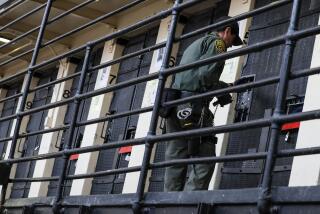Jury Selection in Haun Trial to Begin on Monday
More than 200 prospective jurors are expected to file into a Santa Barbara meeting room Monday for the first phase of jury selection in the murder trial of Diana Haun.
Jury candidates will be asked to fill out questionnaires probing their knowledge of the high-profile case. Panelists will be quizzed on their attitudes about the death penalty, infidelity and gender.
Their response to the question on infidelity stands to be of special interest since Haun is accused of plotting the murder of her lover’s wife, Sherri Dally.
And after reviewing the responses, lawyers will return to court Wednesday to begin weeding out those who cannot serve during a trial expected to last into the fall.
As they sort through the prospective panelists, legal experts say prosecutors and defense lawyers will be looking for clues--age, occupation, education and life experiences--to lead them to the ideal juror.
“You’re looking for bias,” said George Eskin, a retired Ventura County defense attorney and former prosecutor. “You are looking for questions, statements and phrases that show a person has a certain view.”
For the defense, liberal intellectuals more likely to break from the pack are good. In this case, so are middle-aged men who may feel protective of the 36-year-old grocery clerk.
Independent, career-minded women are bad for the defense but good for the prosecution, experts say. The same holds true for homemakers, people who identify with the victim and bookworms intrigued by a case involving allegations of murder, conspiracy, adultery and kidnapping.
“I think you want jurors who read romance mystery books,” said Laurie Levenson, associate dean of Loyola Law School and a former federal prosecutor. “People who can buy into the intrigue of a woman killer.”
Experts say picking the Haun jurors will be a challenge to lawyers on both sides.
“It’s a tough pick,” said David Graeven, president of Trial Behavior Consulting Inc., a San Francisco-based firm that advises attorneys on jury selection.
“How does the murder of a mother of two young children, which is a heinous crime and something offensive to both women and men, affect the jurors?” he asked.
In this case, Graeven said, the trick for the prosecution will be to find jurors so outraged by the brutality of the killing they will convict and sentence the defendant to death.
The challenge for the defense, meanwhile, will be to find strong-minded individuals willing to acquit or hold out for a lesser verdict.
“I think with the death penalty there is an art,” he said. “How good is the defense and the prosecution at ferreting out people who are going to hang it?”
*
Haun is accused of stabbing and bludgeoning 35-year-old homemaker Sherri Dally last year, allegedly executing a plot crafted by her and longtime lover Michael Dally.
Both are charged with murder, kidnapping and conspiracy, plus allegations that Sherri Dally was killed for financial gain after her attackers lay in wait.
Haun and Dally are facing the death penalty if convicted at separate trials. His will follow hers, which is expected to end in mid-October.
Concerned about excessive pretrial publicity, a judge decided the Haun jury should come from Santa Barbara County. Jury selection is expected to take at least 2 1/2 weeks.
During the screening, a variety of provocative issues are expected to be raised, including the innocence of the victim, the viciousness of her killing and the love affair between the two defendants.
Prosecutors also plan to query panelists on whether they would be willing to give a death sentence to a woman.
*
“The big issue here, just sort of on an intuitive level, is gender,” Graeven said.
In every capital case, persuading a jury to sentence a defendant to death is difficult, experts say. But when the defendant is a woman, the task is even tougher, they say.
As a result, experts said, the prosecution needs to prove that someone who looks nice on the outside is evil on the inside.
“I think it is often hard for juries to convict women--they just don’t look like murderers,” Levenson said.
Older, male jurors may benefit the defense, Levenson said, saying it is easier for them to believe the defendant could be an unwitting pawn to a male co-conspirator.
“I think men tend to be a little paternalistic when it comes to women defendants,” she said. “They might also want women jurors who have been exposed to overbearing men.”
What the defense does not want, she said, are very independent women.
“I think that those women are less likely to buy into the scenario that she was just the pawn of another man, they are more likely to accept the prosecution argument that she was responsible for her acts,” Levenson said.
Women are rarely arrested on suspicion of murder, and fewer still are prosecuted in capital murder cases.
Only eight women now wait on death row for execution, compared with 477 men. While only two death penalty cases are now pending against women in this state, an average of three men are sent to death row by California judges each month.
*
In this century, the state has executed only four women, the last of whom was put to death in 1962 after the most celebrated trial in Ventura County history.
Elizabeth Ann Duncan was convicted of first-degree murder in 1959 for orchestrating the killing of her pregnant daughter-in-law, Olga Kupczyk.
Duncan paid two hirelings $6,000 to kidnap and kill the 30-year-old nurse. One of the men later led police to a shallow grave near Lake Casitas where they buried her.
More to Read
Sign up for Essential California
The most important California stories and recommendations in your inbox every morning.
You may occasionally receive promotional content from the Los Angeles Times.










